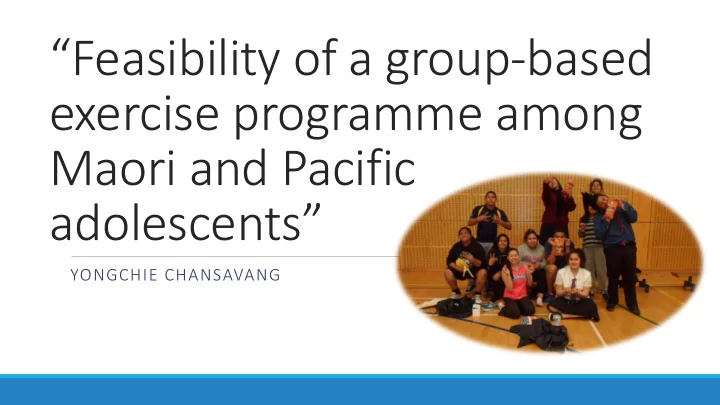

“Feasibility of a group-based exercise programme among Maori and Pacific adolescents” YONGCHIE CHANSAVANG
Introduction 1. Benefits of physical activity 2. Harms of physical inactivity 3. Physical inactivity in Maori and Pacific Island adolescents 4. The adolescent exercise intervention 5. Methods and Participants 6. Intervention 7. Data Collection 8. Results 9. Conclusions, Implications and Recommendations
Benefits of physical activity in adolescents 1. develop healthy musculoskeletal tissues (i.e. bones, muscles and joints) 2. develop a healthy cardiovascular system (i.e. heart and lungs) 3. develop neuromuscular awareness (i.e. coordination and movement control); 4. maintain a health body weight 5. reduction in the risk of diabetes and many other diseases 6. reduction in anxiety and depression 7. adoption of healthy behaviours carried into adulthood
Harms of physical inactivity • Fourth leading risk factor for global mortality (WHO, 2013) • Accounts for 3.2 million deaths globally • Higher risk of developing Type 2 diabetes, ovarian/colon/breast cancers, osteoporosis, and depression.....
Maori and P.I Adolescents • Highest obesity rate in comparison to all other ethnic groups and rising • Pacific 5.3 times more likely to develop obesity • Higher inactivity levels than rest of popn • Half do not participate in sport • HOWEVER... High incidental physical activity
Aims and objectives of the study 1. Is it feasible to run an exercise program that will encourage adolescents to increase their own physical activity? 2. In a group of less active adolescents at risk of diabetes in later life, can a group-based exercise programme increase fitness and usual activity and reduce insulin resistance over 6 weeks? 3. Will there be an increase in the duration of physical activity and VO2max in a 6 week exercise intervention? Ethics and trial registration The study was granted approval by The University of Auckland Human Participants Ethics Committee (ref. 9819) on 19/06/2013 for a period of three years. The pilot study was registered with the Australian New Zealand Clinical Trials Registry (ANZCTR): ACTRN12613000691741.
The Adolescent Exercise Study Participants: Study design: ◦ Senior students attending Tamaki College "Before-after" intervention feasibility study of an between 16-18 years of age* exercise and educational intervention ◦ Physically inactive or engaging in less than two organised exercise or sports sessions per week on a regular basis 1 intervention group and follow-up completed ◦ Interested in an exercise program to improve immediately post-in fitness and health *Under-16s offered participation only if sample size does not exceed maximum capacity of 30 participants. Pilot for larger RCT
The Intervention Group-based exercise and lifestyle intervention programme held in community gym straight after school, 3 times a week over a 6 week period. 1 hour long sessions including a variety of moderate-high intensity activities such as dancing, basketball, touch-rugby, games, interval training, kickboxing and many more Healthy snacks and education provided at the end of each session Social support and motivation through txts
Data Collection- assessed at baseline and 6 weeks Secondary outcomes: Primary outcome measures: 1. Usual physical activity levels: using the short 1. Cardio-respiratory fitness (VO2max): as form of the international physical activity assessed by the ‘1-mile walk test’. questionnaire (IPAQ) 3 , accelerometer and smart phone 2. Waist circumference 2. Insulin resistance*: calculated according to Homeostatic Model, using fasting blood 3. HbA1c* glucose and insulin levels 4. Blood pressure 5. Fasting lipid profile* 6. Attendance at exercise sessions *Blood tests are voluntary, obtained with consent
Some senior students in the program re-fuelling with bananas post- workout Fruit kindly donated by Dole
Preliminary results 20 students enrolled with consent given, ages 15-18- Mean 16.45 years (1.1) 12 participants completed the program on a regular basis (attended more than 10 sessions out of 17) Data analysis still underway Unconcluded findings (initial impressions) 1. Improvements in cardio-respiratory fitness 2. Improvements in insulin resistance 3. Increase in physical activity shown in IPAQ 4. Weight loss 5. Steady attendance 6. Feeling happier, fitter, more confident
Conclusions, Implications and Recommendations An increase in physical activity and education may improve cardio-respiratory fitness and usual activity in sedentary Maori and Pacific Islander adolescents A group-based exercise programme can be easily sustained and appears to be a promising means for improving fitness and reducing the risk of diabetes and CVD in Maori and Pacific secondary students Measures were feasible and performed well Findings from this study can help to inform future youth exercise programmes Contribute to the running of an exercise trial (on a larger scale) in the near future The inclusion of more group-based aerobic games in future exercise programmes with this population More research is still needed
Acknowledgements The University of Auckland: Dr Raina Elley (General Practice and Primary Health Care) Dr Lance Dalleck (Sports and Exercise Science Dr Ofa Dewes (Pacific Health) Dr Ralph Maddison (National Institute for Health Innovation) Miss Brighid McCaffrey (Sports and Exercise Science) Miss Chloe Davidson (Sports and Exercise Science) Community: Mr Lee Jones (Tamaki community gym manager) Mr Jason Borland (Head of the Dept of Physical Education) Mrs Soana Pamaka, (Tamaki College principal) Miss Tania Crothall (Tamaki Clinic Nurse) Sponsored by: MOH ‘Kete Moui o Tamaki’ grant, PBRS grant, New World Lunn Ave, Countdown, Dole and Schultz
Recommend
More recommend